Liverpool are learning the hard way that success doesn’t last unless the team is constantly being improved and upgraded. In a competitive environment, no unchanged side has a lifespan of more than two or three years. Problems have been accelerated by injuries, but the Reds are no exception.
They need to re-invest to build the next team and stop this one from being no more than a flash in the pan, but whether they can actually afford to do that at the level required is in serious doubt.
This Liverpool team was largely put together between 2016 and 2018. The Reds reached the Champions League in 2018, won the Champions League in 2019 and finally ended a 30-year English league title drought in 2020. It is now 2021 and three years since the finishing touches were added.

The club barely added to the squad between the 2018/19 and 2019/20 campaigns, completing the latter with a transfer market profit close to £30m. Part of that will have been down to huge spending in 2018 when Virgil van Dijk, Fabinho, Alisson and Naby Keita all arrived.
Liverpool had also sold Philippe Coutinho to Barcelona that year in a deal worth up to £142m. A significant chunk of that fee was to be through add-ons and at last count three years later, the Reds were still owed nearly £60m of the overall figure in some form or another.
In other words, Coutinho’s sale, while helpful, didn’t simply pay for the 2018 arrivals. The club has since also stripped back the squad without replacing the depth, which is hurting them now.
Despite selling Dejan Lovren and leaving themselves with only three specialised senior centre-backs, Liverpool decided against replacing the Croatian in the summer of 2020.

Instead, they opted to make do without spending in that position and review the situation again in summer 2021 with a focus geared towards the long-term. They might have got away with it in different circumstances, but season-ending injuries to Van Dijk, Joe Gomez and later also Joel Matip brutally exposed the rather self-inflicted lack of depth in the centre of defence.
Even up until the end of the 2021 January transfer window, Liverpool were still determined not to spend. Ben Davies was eventually a cheap stop-gap and Ozan Kabak was a cheap loan. Noticeably, the latter arrived with an option to buy, rather than any pre-set obligation.
Fans had lauded sporting director Michael Edwards for a £20m summer deal to sign Thiago Alcantara from Bayern Munich for just £5m up front and only £5m per season thereafter. The club were similarly thought to have only paid £4m up front for the £45m transfer of Diogo Jota from Wolves.
Instalment plans are far more common in transfer dealings than the media usually cares to let on, but spending so little up front on two major signings is an indicator of a lack of liquid cash.
When Jamie Carragher said in response to this week’s defeat to Chelsea, an unprecedented fifth in a row at Anfield in league competition, “…Liverpool need to do something big in the transfer market in terms of bringing someone in to score goals…”, it is not that simple.
Fans want Kylan Mbappe or Erling Haaland. Either would be a perfect addition. But despite the way they dominated English football last season and were crowned champions of Europe and then the world in 2019, Liverpool don’t have the resources to land either without serious concessions. That could be through even more players sales or the riskier idea of staggered payment plans well into the future to minimise immediate costs, serving to only kick the financial can a down the road.
The lack of significant transfer spending since 2018, all the while usually selling fringe players like Danny Ings, Dominic Solanke, Danny Ward, Rhian Brewster and Ryan Kent at a premium, is indicative that they may still be limited by the vast expense of building this team in the first place.
Klopp has spoken about Mbappe in the past, acknowledging his admiration for the player but in the next breath ruling it out because of the figures that would be involved.
What a player he is. But it is about the money of course. No chance. Absolutely no chance. Sorry for killing that story.Klopp on Kylian Mbappe, November 2019

Supporters have taken issue with club owners FSG, demanding that Klopp be backed in the transfer market. But the Americans, who are firm believers in the Moneyball principles seen in Major League Baseball, have not bank-rolled the club’s success, nor are they withholding money for the sake of it.
FSG don’t provide the money, not least because owner-investment can easily fall foul of UEFA. Rather, they manage the finances, trying to find ways to streamline and grow various revenues to pay for things like better infrastructure, more expensive players and bigger contracts.
Bringing Nike on board as a partner was perceived as a money-maker that would fund approaches for players like Mbappe. The 2020 deal is of huge importance for long-term commercial gain and global reach, but it cannot be considered like a winning lottery ticket with an instant cash prize.
It is also worth remembering that Liverpool have invested considerably in infrastructure in recent years, both in the redevelopment of Anfield and the building of a brand new training ground.

In 2020, the club attempted to make use of government assistance by furloughing non-playing staff at the start of the coronavirus crisis. Public pressure forced a swift U-turn and the fact it was an inevitable PR own goal suggests trying it in the first place would not have been taken lightly. As a cost saving measure when revenues were badly hit, there was a clear advantage to it.
Liverpool had no choice but to spend big in 2018 because the team was on the cusp of something very special. It was a gamble that enormously paid off, but it was not without consequence because the money is never limitless and always has to come from somewhere, even it that means effectively ‘borrowing’ from their future selves and a mantra of ‘spend now, scrimp later’.
A club with Liverpool’s recent record of success, that was willing to spend heavily to help achieve that success, would undoubtedly spend to maintain that success if they had the financial power to. That they have instead been so reluctant probably tells you what you need to know.
For more from Jamie Spencer, follow him on Twitter and Facebook!
Source : 90min
